Ingredients
Biga
11 ounces bread flour (2 cups)
¼ teaspoon instant yeast
8 ounces water (1 cup), room temperature
Dough
16 ½ ounces bread flour (3 cups), plus extra for dusting hands and work surface
1 teaspoon instant yeast
10.7 ounces water (1 1/3 cups), room temperature
2 teaspoons table salt
Description
For a rustic Italian bread recipe with a chewy but tender crumb, crusty but not tough, we used bread flour, which gave our bread height and a thick crust. Biga (a traditional Italian pre-ferment) mixed the day before gave the bread a wheaty, multidimensional flavor. A mixing technique called autolyse developed the dough’s protein while reducing kneading time.
Directions
This recipe requires a standing mixer to make the dough, a spray-bottle filled with water for spritzing, a rectangular baking stone, and an instant-read thermometer for gauging doneness. It also requires a bit of patience—the biga, which gives the bread flavor, must be made 11 to 27 hours before the dough is made.
For the biga: Combine flour, yeast, and water in bowl of standing mixer fitted with dough hook. Knead on lowest speed (stir on KitchenAid) until it forms a shaggy dough, 2 to 3 minutes. Transfer biga to medium bowl, cover tightly with plastic wrap, and let stand at room temperature until beginning to bubble and rise, about 3 hours. Refrigerate biga at least 8 hours or up to 24 hours.
For the dough: Remove biga from refrigerator and let stand at room temperature while making dough. Combine flour, yeast, and water in bowl of standing mixer fitted with dough hook; knead on lowest speed until rough dough is formed, about 3 minutes. Turn mixer off and, without removing dough hook or bowl from mixer, cover bowl loosely with plastic wrap; let dough rest 20 minutes.
Remove plastic wrap, add biga and salt to bowl, and continue to knead on lowest speed until ingredients are incorporated and dough is formed (dough should clear sides of bowl but stick to very bottom), about 4 minutes. Increase mixer speed to low (speed 2 on KitchenAid) and continue to knead until dough forms a more cohesive ball, about 1 minute. Transfer dough to large bowl (at least 3 times dough’s size) and cover tightly with plastic wrap. Let dough rise in cool, draft-free spot away from direct sunlight, until slightly risen and puffy, about 1 hour.
Remove plastic wrap and, following illustrations from "Step by Step: Turning the Dough", turn dough. Replace plastic wrap; let dough rise 1 hour. Turn dough again, replace plastic wrap, and let dough rise 1 hour longer.
"Turning the Dough": Slide plastic bench scraper under one side of dough; gently lift and fold one third of dough toward center. Do this again with opposite side of dough. Finally, fold dough in half, perpendicular to first folds. Dough shape should be a rough square.
To shape the dough: Dust work surface liberally with flour. Gently scrape and invert dough out of bowl onto work surface (side of dough that was against bowl should now be facing up). Dust dough and hands liberally with flour and, using minimal pressure, push dough into rough 8- to 10-inch square. Following illustrations from "Step by Step: Shaping the Loaf", shape dough and transfer to large sheet parchment paper. Dust loaf liberally with flour and cover loosely with plastic wrap; let loaf rise until doubled in size, about 1 hour. Meanwhile, adjust oven rack to lower-middle position, place baking stone on rack, and heat oven to 500 degrees.
"Shaping the Loaf" instructions: After delicately pushing dough into 8- to 10-inch square, fold top left corner diagonally to middle. Repeat step 2 with top right -corner. Begin to gently roll dough from top to bottom. Continue rolling until dough forms a rough log. Roll dough onto its seam and, sliding hands underneath each end, transfer dough to parchment paper. Gently shape dough into 16-inch football shape by tucking bottom edges underneath.
To bake: Using a lame, single-edged razor blade, or sharp chef’s knife, cut slit 1/2 inch deep lengthwise along top of loaf, starting and stopping about 1 1/2 inches from ends; spray loaf lightly with water. Slide parchment sheet with loaf onto baker’s peel or upside-down baking sheet, then slide parchment with loaf onto hot baking stone in oven. Bake 10 minutes, then reduce oven temperature to 400 degrees and quickly spin loaf around using edges of parchment; continue to bake until deep golden brown and instant-read thermometer inserted into center of loaf registers 210 degrees, about 35 minutes longer. Transfer to wire rack, discard parchment, and cool loaf to room temperature, about 2 hours.
Notes
Doubled the recipe for Christmas, and it made 16 sandwich rolls. In the dough shaping steps, we simply divided the dough into 16ths, pressed each piece flat, and then rolled up to make a log. We placed 8 rolls on a baking sheet (probably too much) and let rise as instructed. We did not do the first bake at 500, but I think we did spritz them with water. We also didn't cook them as long, but I'm not sure how long we went.
Also, the recipe is funky since ATK refers to some illustrated drawings that aren't easy to reference here....sorry.
Nutrition
Calories: 2830
